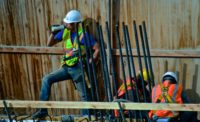Despite contractors’ opposition, the U.S. Dept. of Labor published a final rule in the Federal Register April 1 concerning nonemployee representatives during workplace safety inspections. The rule, effective May 31, allows employees to select a third party to represent them during Occupational Safety and Health Administration inspections.
A nonemployee representative may be needed to provide knowledge such as experience with hazards or conditions in similar workplaces or language and communication skills, according to OSHA officials. They add that the rule is consistent with historic OSHA practice, but is needed for clarification following a 2017 court ruling that found an existing regulation, as written, only allowed employees as representatives.
Worker involvement in inspections is essential for thoroughness and effectiveness in making workplaces safer, Doug Parker, an OSHA assistant secretary, said in a statement.
“The Occupational Safety and Health Act gives employers and employees equal opportunity to choose representation during the OSHA inspection process, and this rule returns us to the fair, balanced approach Congress intended,” Parker said.
Labor groups celebrated the final rule. The rule “is a welcome improvement that will empower workers and improve safety,” Brent Booker, general president of the Laborers’ International Union of North America, said in a statement.
Contractors continue their objections, which they stated last fall, after Labor Dept. officials released the proposed rule. The final rule will make it more difficult to ensure workplace safety as it “essentially forces contractors to allow anyone—regardless of their safety training and experience—onto active jobsites,” says Brian Turmail, vice president of public affairs and strategic initiatives at the Associated General Contractors of America.
“Sometimes we disagree with the agency about its particular approach to solving real safety hazards and whether that approach will be effective,” Turmail adds. “But it is hard to remember a time when the agency has promulgated a rule that creates so many safety hazards while solving so few.”
Specifically, last fall, contractors had raised concerns about allowing workers to choose a third-party representative from a union on a nonunion job, or that a chosen third-party could be gathering information for a lawsuit against the employer.
The rule has negative impacts on the rights of employers and of employees who do not want union representation, Greg Sizemore, vice president of health, safety, environment and workforce development at the Associated Builders and Contractors, said in a statement.
“By allowing outside union agents access to nonunion employers’ private property, OSHA is injecting itself into labor-management disputes and casting doubt on its status as a neutral enforcer of the law,” Sizemore said.
Contractors also questioned who would be responsible for a third-party representative’s actions on a site, their potential liability if a representative were injured and who would be responsible for providing personal protective equipment.
Representatives from the contractor groups would not say whether they were planning a legal challenge to the rule, but both say they are “exploring all options.”





Post a comment to this article
Report Abusive Comment